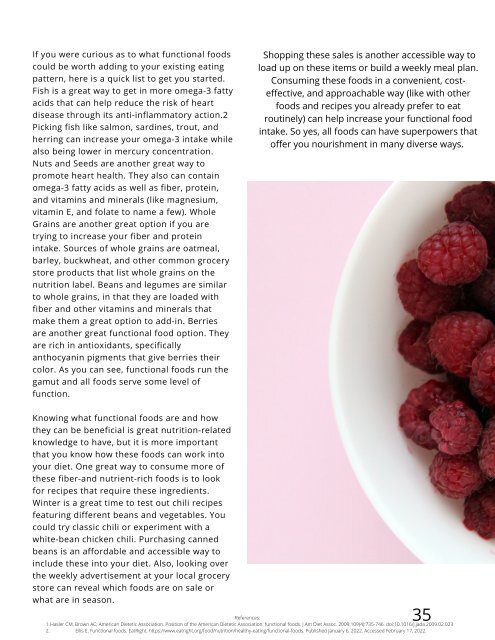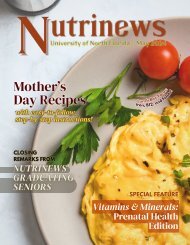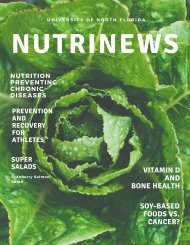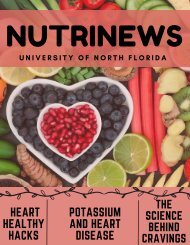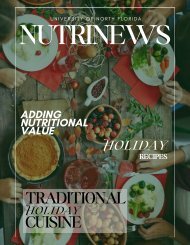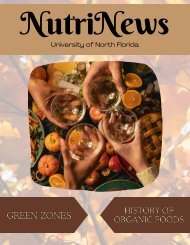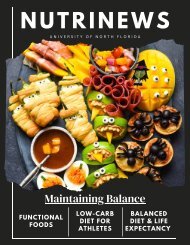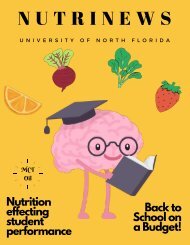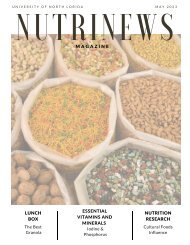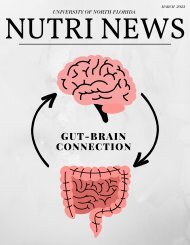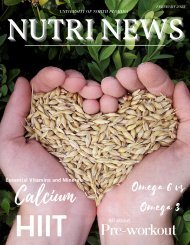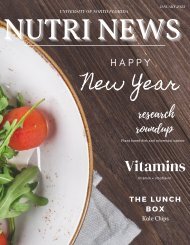march issue
Hello all! The theme for March is National Nutrition Month! Topics include How Nutrition Can Influence Our Health and The Evolution of Hospital Food. This month’s student spotlight is on our very own Alicia Blong. I hope you all enjoy, learn, and get inspired by this month’s articles and recipes!
Hello all!
The theme for March is National Nutrition Month! Topics include How Nutrition Can Influence Our Health and The Evolution of Hospital Food. This month’s student spotlight is on our very own Alicia Blong.
I hope you all enjoy, learn, and get inspired by this month’s articles and recipes!
You also want an ePaper? Increase the reach of your titles
YUMPU automatically turns print PDFs into web optimized ePapers that Google loves.
If you were curious as to what functional foods<br />
could be worth adding to your existing eating<br />
pattern, here is a quick list to get you started.<br />
Fish is a great way to get in more omega-3 fatty<br />
acids that can help reduce the risk of heart<br />
disease through its anti-inflammatory action.2<br />
Picking fish like salmon, sardines, trout, and<br />
herring can increase your omega-3 intake while<br />
also being lower in mercury concentration.<br />
Nuts and Seeds are another great way to<br />
promote heart health. They also can contain<br />
omega-3 fatty acids as well as fiber, protein,<br />
and vitamins and minerals (like magnesium,<br />
vitamin E, and folate to name a few). Whole<br />
Grains are another great option if you are<br />
trying to increase your fiber and protein<br />
intake. Sources of whole grains are oatmeal,<br />
barley, buckwheat, and other common grocery<br />
store products that list whole grains on the<br />
nutrition label. Beans and legumes are similar<br />
to whole grains, in that they are loaded with<br />
fiber and other vitamins and minerals that<br />
make them a great option to add-in. Berries<br />
are another great functional food option. They<br />
are rich in antioxidants, specifically<br />
anthocyanin pigments that give berries their<br />
color. As you can see, functional foods run the<br />
gamut and all foods serve some level of<br />
function.<br />
Shopping these sales is another accessible way to<br />
load up on these items or build a weekly meal plan.<br />
Consuming these foods in a convenient, costeffective,<br />
and approachable way (like with other<br />
foods and recipes you already prefer to eat<br />
routinely) can help increase your functional food<br />
intake. So yes, all foods can have superpowers that<br />
offer you nourishment in many diverse ways.<br />
Knowing what functional foods are and how<br />
they can be beneficial is great nutrition-related<br />
knowledge to have, but it is more important<br />
that you know how these foods can work into<br />
your diet. One great way to consume more of<br />
these fiber-and nutrient-rich foods is to look<br />
for recipes that require these ingredients.<br />
Winter is a great time to test out chili recipes<br />
featuring different beans and vegetables. You<br />
could try classic chili or experiment with a<br />
white-bean chicken chili. Purchasing canned<br />
beans is an affordable and accessible way to<br />
include these into your diet. Also, looking over<br />
the weekly advertisement at your local grocery<br />
store can reveal which foods are on sale or<br />
what are in season.<br />
35<br />
References:<br />
1. Hasler CM, Brown AC; American Dietetic Association. Position of the American Dietetic Association: functional foods. J Am Diet Assoc. 2009;109(4):735-746. doi:10.1016/j.jada.2009.02.023<br />
2.<br />
Ellis E. Functional foods. EatRight. https://www.eatright.org/food/nutrition/healthy-eating/functional-foods. Published January 6, 2022. Accessed February 17, 2022.


